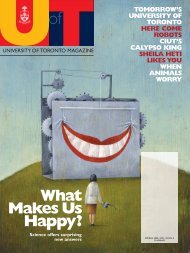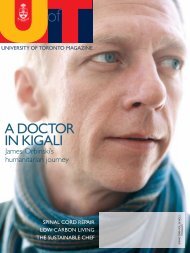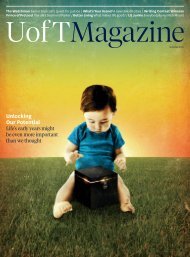The Next Big Idea 10 concepts that could - University of Toronto ...
The Next Big Idea 10 concepts that could - University of Toronto ...
The Next Big Idea 10 concepts that could - University of Toronto ...
Create successful ePaper yourself
Turn your PDF publications into a flip-book with our unique Google optimized e-Paper software.
Computers That Understand Speech<br />
New s<strong>of</strong>tware can condense long spokenword<br />
recordings into a few key highlights<br />
Ever since Star Trek first aired, we’ve imagined a world where<br />
we <strong>could</strong> simply talk to our computers and listen to their<br />
replies, without the clunky diversion <strong>of</strong> typing and reading.<br />
Suppose, for example, <strong>that</strong> you missed an important meeting:<br />
wouldn’t it be great if a computer <strong>could</strong> just tell you what the<br />
highlights were<br />
Gerald Penn, a pr<strong>of</strong>essor <strong>of</strong> computer science, has been<br />
working toward this goal. His specialty is “speech summarization”<br />
– not by the traditional method, which would require a<br />
human to transcribe every word spoken, but rather an automated<br />
process <strong>that</strong> uses audio recordings <strong>of</strong> the events<br />
themselves, bypassing text altogether.<br />
Penn is developing s<strong>of</strong>tware <strong>that</strong> can listen to an audio file<br />
(an MP3 <strong>of</strong> a recorded speech, for example) and keep track <strong>of</strong><br />
pauses, emphasis and repeated words – what he calls “recurring<br />
acoustic patterns.” <strong>The</strong> s<strong>of</strong>tware then uses those indicators to<br />
condense the audio recording into a new, shorter file <strong>that</strong> contains<br />
the most salient points <strong>of</strong> the original. And it can do it quickly,<br />
too, processing a one-hour recording in just a few minutes.<br />
Until now, Penn says, you would have had to make do with<br />
a textual summary. But a text-based summary requires a transcript,<br />
and these are time-consuming if done manually and<br />
typically error-riddled when done by a computer program.<br />
Even if speech-recognition programs were error-free, a perfect<br />
transcript would hold little appeal, given <strong>that</strong> human speech<br />
is full <strong>of</strong> “ums” and “ahs,” sentences <strong>that</strong> seem to change gear<br />
in the middle, and strings <strong>of</strong> words and phrases <strong>that</strong> generally<br />
flout the rules <strong>of</strong> grammar. A condensed audio file, in<br />
contrast, still conveys the key message <strong>of</strong> a given speech, Penn<br />
says, without sounding jarring to the ear.<br />
Potential demand for the s<strong>of</strong>tware <strong>could</strong> come from any field<br />
where short summaries <strong>of</strong> spoken-word content are required –<br />
such as businesses <strong>that</strong> need brief accounts <strong>of</strong> speeches or news<br />
broadcasts; students who need summaries <strong>of</strong> lectures at exam<br />
time; or even government security agencies on the lookout<br />
for signs <strong>of</strong> criminal activity in phone conversations.<br />
<strong>The</strong> next step, Penn says, will be to compare computergenerated<br />
summaries with those generated by humans, to<br />
see how well they match up – bearing in mind <strong>that</strong> human<br />
listeners might not agree with each other about what the<br />
most important points in a given speech were. Collaborations<br />
with colleagues in psychology are a possibility. “We need<br />
to consider what artificial intelligence is all about,” he says.<br />
– Dan Falk<br />
DNA and Diet Why can some people<br />
drink all the c<strong>of</strong>fee they want and others<br />
can’t <strong>The</strong> answer may be genetic<br />
Reducing your salt intake <strong>could</strong> save your life – or imperil it.<br />
It depends on your genes. Same thing with c<strong>of</strong>fee: four cups<br />
a day <strong>could</strong> be divine for me but dangerous for you. How can<br />
we know At the moment, it isn’t easy. But <strong>that</strong>’s something<br />
Dr. Ahmed El-Sohemy, a pr<strong>of</strong>essor in the Faculty <strong>of</strong> Medicine,<br />
is working to change.<br />
El-Sohemy holds the Canada Research Chair in Nutrigenomics,<br />
which is a branch <strong>of</strong> nutritional science <strong>that</strong> explores<br />
how the nutrients we consume interact with our genes to<br />
affect our health. His research has bolstered the idea <strong>that</strong> our<br />
genetic makeup determines in part how we react to certain<br />
foods. In 2006, for instance, El-Sohemy and his colleagues<br />
published a startling paper in the Journal <strong>of</strong> the American Medical<br />
Association about c<strong>of</strong>fee drinkers. People with a particular<br />
gene variant metabolize caffeine slowly. So whereas genetically<br />
“fast” metabolizers can drink all the c<strong>of</strong>fee they want<br />
with impunity, slowpokes under the age <strong>of</strong> 50 have a four-fold<br />
increased risk <strong>of</strong> heart attack when they imbibe four or more<br />
cups per day. And, lest you think you can tell your genotype<br />
by whether the dark stuff keeps you up at night, <strong>that</strong> effect is<br />
totally unrelated, he says.<br />
This is the sort <strong>of</strong> useful genetic detail we’d all like to know<br />
about ourselves. Luckily, El-Sohemy and others are at work<br />
on a personalized nutrigenomics test kit. In addition to pinpointing<br />
our caffeine risk, the test will reveal whether we will<br />
be deficient in vitamin C if we don’t take the recommended<br />
daily allowance <strong>of</strong> 75 to 90 milligrams and whether we should<br />
curb our salt habit. Guidelines tend to focus on the upper and<br />
lower limits, he points out, but not the individual: “You are<br />
just one point in the range,” he says. – Alison Motluk<br />
28 WWW.MAGAZINE.UTORONTO.CA
















